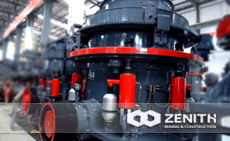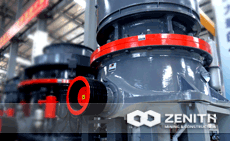Granite Instruction And Application In Antiquity And Modern Society
Granite is a common type of intrusive, felsic, igneous rock which is granular and phaneritic in texture. This rock consists mainly of quartz, mica, and feldspar. Occasionally some individual crystals (phenocrysts) are larger than the ground mass, in which case the texture is known as porphyritic. A granitic rock with a porphyritic texture is sometimes known as a porphyry. Granite can be pink to gray in color, depending on their chemistry and mineralogy. By definition, granite is an igneous rock with at least 20% quartz by volume. Granite differs from granodiorite in that at least 35% of the feldspar in granite is alkali feldspar as opposed to plagioclase; it is the alkali feldspar that gives many granite a distinctive pink color. Outcrops of granite tend to form tors and rounded massifs. Granite sometimes occur in circular depression surrounded by a range of hills, formed by the metamorphic aureole or hornfels. Granite is usually found in the continental plates of the Earth’s crust.
Granite is nearly always massive (lacking internal structures), hard and tough, and therefore it has gained widespread use as a construction stone. The average density of granite is between 2.65[1] and 2.75 g/cm3, its compressive strength usually lies above 200 MPa, and its viscosity near STP is 3-6 ? 1019 Pa?s. Melting temperature is 1215 – 1260 °C.
The word “granite” comes from the Latin granum, a grain, in reference to the coarse-grained structure of such a crystallinerock.
Granitoid is a general, descriptive field term for light-colored, coarse-grained igneous rocks. Petrographic examination is required for identification of specific types of granitoids.
Mineralogy
Granite is classified according to the QAPF diagram for coarse grained plutonic rocks and is named according to the percentage of quartz, alkali feldspar (orthoclase, sanidine, or microcline) and plagioclase feldspar on the A-Q-P half of the diagram. True granite according to modern petrologic convention contains both plagioclase and alkali feldspars. When a granitoid is devoid or nearly devoid of plagioclase, the rock is referred to as alkali granite. When a granitoid contains less than 10% orthoclase, it is called tonalite; pyroxene and amphibole are common in tonalite. A granite containing both muscovite and biotite micas is called a binary or two-mica granite. Two-mica granites are typically high in potassium and low in plagioclase, and are usually S-type granites or A-type granites. The volcanic equivalent of plutonic granite is rhyolite. Granite has poor primary permeability but strong secondary permeability.
Application Of Granite
Antiquity
Rajaraja Chola I of the Chola Dynasty in South India built the world’s first temple entirely of granite in the 11th century AD inTanjore, India. The Brihadeeswarar temple Brihadeeswarar Temple dedicated to Lord Shiva was built in 1010. The massive Gopuram (ornate, upper section of shrine) is believed to have a mass of around 81 tonnes. It was the tallest temple in south India.
Many large Hindu temples in southern India, built by the Chozha (/Chola) Emperor Rajaraja Chola I, were made of granite. There is a large amount of granite in these structures. They are comparable to the Great Pyramid of Giza.
Many large Hindu temples in southern India, built by the Chozha (/Chola) Emperor Rajaraja Chola I, were made of granite. There is a large amount of granite in these structures. They are comparable to the Great Pyramid of Giza.
Modern Sculpture and memorials
In some areas granite is used for gravestones and memorials. Granite is a hard stone and requires skill to carve by hand. Until the early 18th century, in the Western world, granite could only be carved by hand tools with generally poor results.
A key breakthrough was the invention of steam-powered cutting and dressing tools by Alexander MacDonald of Aberdeen, inspired by seeing ancient Egyptian granite carvings. In 1832 the first polished tombstone of Aberdeen granite to be erected in an English cemetery was installed at Kensal Green cemetery. It caused a sensation in the London monumental trade and for some years all polished granite ordered came from MacDonald. Working with the sculptor William Leslie, and later Sidney Field, granite memorials became a major status symbol in Victorian Britain. The royal sarcophagus at Frogmore was probably the pinnacle of its work, and at 30 tons one of the largest. It was not until the 1880s that rival machinery and works could compete with the MacDonald works.
Modern methods of carving include using computer-controlled rotary bits and sandblasting over a rubber stencil. Leaving the letters, numbers and emblems exposed on the stone, the blaster can create virtually any kind of artwork or epitaph.
Buildings
Granite has been extensively used as a dimension stone and as flooring tiles in public and commercial buildings and monuments. Aberdeen in Scotland, which is constructed principally from local granite, is known as “The Granite City”. Because of its abundance, granite was commonly used to build foundations for homes in New England. The Granite Railway, America’s first railroad, was built to haul granite from the quarries in Quincy, Massachusetts, to the Neponset River in the 1820s. With increasing amounts of acid rain in parts of the world, granite has begun to supplant marble as a monument material, since it is much more durable. Polished granite is also a popular choice for kitchen countertops due to its high durability and aesthetic qualities. In building and for countertops, the term “granite” is often applied to all igneous rocks with large crystals, and not specifically to those with a granitic composition.
Engineering
Engineers have traditionally used polished granite surface plates to establish a plane of reference, since they are relatively impervious and inflexible. Sandblasted concrete with a heavy aggregate content has an appearance similar to rough granite, and is often used as a substitute when use of real granite is impractical. A most unusual use of granite was in the construction of the rails for the Haytor Granite Tramway, Devon, England, in 1820. Granite block is usually processed into slabs and after can be cut and shaped by a cutting center. Granite tables are used extensively as a base for optical instruments due to granite’s rigidity, high dimensional stability and excellent vibration characteristics.




